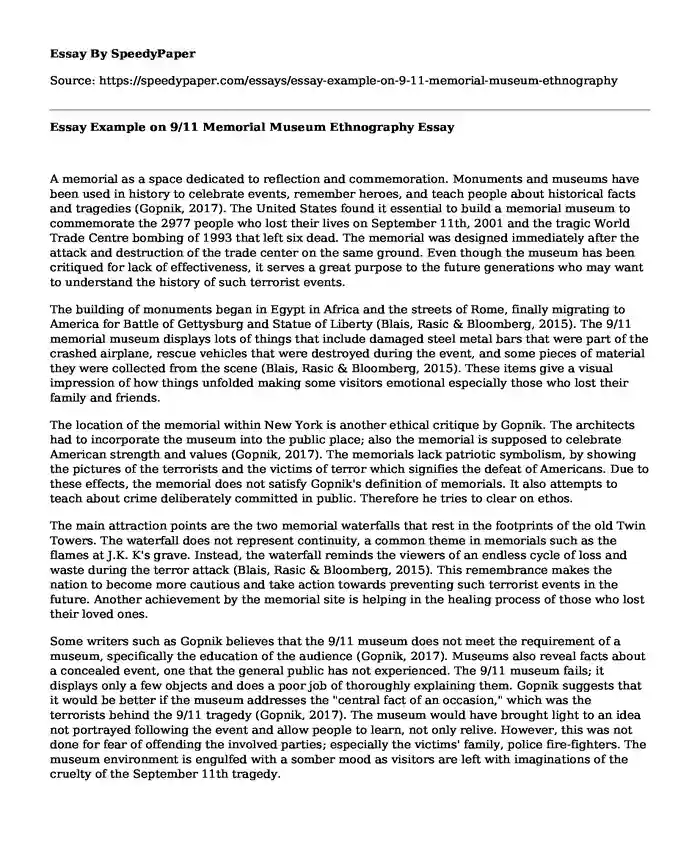
| Type of paper: | Essay |
| Categories: | Terrorism Ethnography American history |
| Pages: | 3 |
| Wordcount: | 656 words |
A memorial as a space dedicated to reflection and commemoration. Monuments and museums have been used in history to celebrate events, remember heroes, and teach people about historical facts and tragedies (Gopnik, 2017). The United States found it essential to build a memorial museum to commemorate the 2977 people who lost their lives on September 11th, 2001 and the tragic World Trade Centre bombing of 1993 that left six dead. The memorial was designed immediately after the attack and destruction of the trade center on the same ground. Even though the museum has been critiqued for lack of effectiveness, it serves a great purpose to the future generations who may want to understand the history of such terrorist events.
The building of monuments began in Egypt in Africa and the streets of Rome, finally migrating to America for Battle of Gettysburg and Statue of Liberty (Blais, Rasic & Bloomberg, 2015). The 9/11 memorial museum displays lots of things that include damaged steel metal bars that were part of the crashed airplane, rescue vehicles that were destroyed during the event, and some pieces of material they were collected from the scene (Blais, Rasic & Bloomberg, 2015). These items give a visual impression of how things unfolded making some visitors emotional especially those who lost their family and friends.
The location of the memorial within New York is another ethical critique by Gopnik. The architects had to incorporate the museum into the public place; also the memorial is supposed to celebrate American strength and values (Gopnik, 2017). The memorials lack patriotic symbolism, by showing the pictures of the terrorists and the victims of terror which signifies the defeat of Americans. Due to these effects, the memorial does not satisfy Gopnik's definition of memorials. It also attempts to teach about crime deliberately committed in public. Therefore he tries to clear on ethos.
The main attraction points are the two memorial waterfalls that rest in the footprints of the old Twin Towers. The waterfall does not represent continuity, a common theme in memorials such as the flames at J.K. K's grave. Instead, the waterfall reminds the viewers of an endless cycle of loss and waste during the terror attack (Blais, Rasic & Bloomberg, 2015). This remembrance makes the nation to become more cautious and take action towards preventing such terrorist events in the future. Another achievement by the memorial site is helping in the healing process of those who lost their loved ones.
Some writers such as Gopnik believes that the 9/11 museum does not meet the requirement of a museum, specifically the education of the audience (Gopnik, 2017). Museums also reveal facts about a concealed event, one that the general public has not experienced. The 9/11 museum fails; it displays only a few objects and does a poor job of thoroughly explaining them. Gopnik suggests that it would be better if the museum addresses the "central fact of an occasion," which was the terrorists behind the 9/11 tragedy (Gopnik, 2017). The museum would have brought light to an idea not portrayed following the event and allow people to learn, not only relive. However, this was not done for fear of offending the involved parties; especially the victims' family, police fire-fighters. The museum environment is engulfed with a somber mood as visitors are left with imaginations of the cruelty of the September 11th tragedy.
Various critiques have diverse and excellent points in about the 9/11 memorial museum, which may not be agreeable by the majority audience because the museum is essential for the future generation to understand the magnitude of the terror attack. Memorial museums help people to be vigilant on terrorism so that the action can be taken before it replicates the previous one and so that the government can take action for the perpetrators.
References
Blais, A., Rasic, L., & Bloomberg, M. (2015). A place of remembrance: Official book of the national September 11 Memorial. Washington D.C.: National Geographic.
Gopnik, A. (2017). "Stones And Bones." The New Yorker, www.newyorker.com/magazine/2014/07/07/stones-and-bones. Accessed 2017.
Cite this page
Essay Example on 9/11 Memorial Museum Ethnography. (2022, Dec 16). Retrieved from https://speedypaper.net/essays/essay-example-on-9-11-memorial-museum-ethnography
Request Removal
If you are the original author of this essay and no longer wish to have it published on the SpeedyPaper website, please click below to request its removal:
- Ethical Leadership Essay Sample
- Project Management Essay Example
- Comparison Essay Sample: Healthcare System in the U.S. and Japan
- Antinatalism in a Philosophy Essay Sample
- Paper Example - Sociological Imagination to Personal Trouble
- Essay Sample on Charismatic Leadership Approach
- Politics and Religion: Should They Be Separated? - Essay Sample
Popular categories




